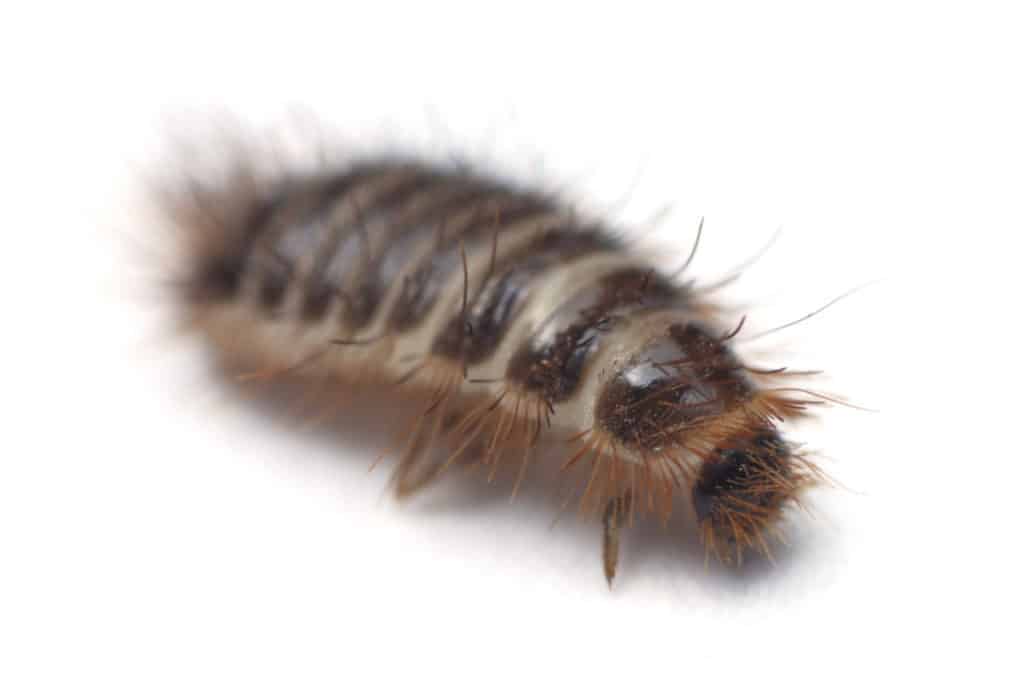Having a bad rep for being incapable of turning down a meal, carpet beetles are not exactly loved insects. In fact, homeowners and pest busters alike have a healthy dread of carpet beetles. Especially since these little guys are often accused of constantly turning their attention to the wrong stuff: like that silk scarf or those comfy woolen stockings.
But what else are carpet beetles likely to sink their fangs into? Does their presence in our homes also pose a danger to our pets? Do carpet beetles bite dogs?

No, carpet beetles don’t pose any real threat to dogs. Adult carpet beetles can hitch a ride on dogs into your house. Carpet beetle larvae love to eat dog hair. The larvae can cause irritation for the dog making the scratch. A good shampoo should free your dog from the larvae.
If carpet beetle larvae are on your dog then there is a very high probability they are in your house especially if your dog is allowed in the house.
Reading on we will we discuss the habits of these ever-present pests and any possible danger they may pose to your pets and your property.
Carpet Beetles’ Lifestyle And Habits
It’s no secret. Most pest control experts consider carpet beetles to be domestic enemy number one. And yet, these insects which emerge in spring and summer tend to live a strictly vegetarian lifestyle. What’s more, they usually spend most of their time enjoying the great outdoors where there is an abundance of pollen, nectar, and seeds to feast on.
So where does their reputation for destruction come from?
The clue to finding out lies in their life cycle:
Mating And Egg-laying
As far as arthropods go, carpet beetles aren’t particularly long-lived. As a matter of fact, they generally have about a couple of weeks (or a few months at the most) to flit around in your garden before they die.
Time is therefore of the essence for these little explorers. Between helping themselves to any pollen and nectar in their immediate vicinity, they must also find a suitable mate to ensure the continuity of their species.
A newly formed couple flits to a well-lit spot where the mating takes place. Once, mated the female lays about 100 eggs. Expectant carpet beetles take their task of giving their young the best possible start in life rather seriously.
Therefore, they lay them in birds’ nests where the tiny larvae will be able to snack on any leftovers provided by their avian host, or even help themselves to a mouthful of feathers, as well. Talking about sneaky, smart moms!
Being of a rather adventurous nature, they may also decide that your home might be the ideal spot for their offspring to come into the world.
In that case, they will search for the darkest and dampest spot available and lay their eggs before taking off once more.
We take a deep dive into what exactly causes carpet beetles to invade your house in another article we have written called, What Causes Carpet Beetles? What Should You Watch Out For?
The Larval Stage
If your home has been selected as the location of choice for a new generation of carpet beetles to come into the world, you might not notice anything immediately.
Everything will stay like it was anywhere between a week to a month once the eggs have been laid. Even when the larvae hatch, you won’t be able to notice anything as they are capable of surviving for several weeks without any food.
All that will however change once their appetite kicks in signaling the start of the most destructive (and incidentally, the longest) phase of these tiny creatures’ lives – a period which will last for an average of nine months (or even twenty-four months in some cases).

At this point, they will set about munching on dust, dried crumbs, hair, pet fur, and even dead insects. They might also take a special interest in your favorite woolen sweaters, scarves, and socks, those silk tops, and rugs – in short, any animal-sourced fibers.
These brown-striped tiny larvae are also not averse to helping themselves to clothes made from plant fabrics such as linen or cotton which happen to be coated with sebum (i.e., the oil produced by the glands in our skin).
And on occasion, they may decide to get their helping of fur directly from the source: your dog. In which case they will cause the furball to experience some discomfort.
The Pupal Phase
Following a reign of terror punctuated by an average of five to eleven molts, the larvae will then spin cocoons in a safe spot and morph into pupae.
This phase generally lasts for two weeks although its duration does depend on the species of carpet beetle. And once it’s over, fully developed adults will emerge from each chrysalis ready to spend the last few weeks of their lives in the open sunshine and bring more larvae with huge appetites into the world.
Now you’ve found that the true culprits are the larvae rather than the adult carpet beetles, it’s time to take a look at how your pet can unwittingly aid the enemy and bring the battle right to your doorstep.
How Your Dog Might Bring Carpet Beetles Indoors
Although these armored bugs are quite capable of sneaking into your home through cracks or flying in through open windows, they are not averse to a free ride either.
While enjoying a mouthful of pollen, they may notice your pet approach to sniff a flower. A savvy carpet beetle will simply hop or fly onto its fur, and drop it off once it’s indoors, and start searching for the perfect spot to lay its eggs.
This invasion is most likely to happen during the spring and summer months which is when these bugs are out in full force.
Should a sufficient number of them take up residence in your home, they may cause considerable damage to items of clothing, rugs and may even cause allergic reactions as well.
If you are interested we have an article on how carpet beetles affect people. Find out if you are at risk. Do Carpet Beetles Bite?
Signs Your Pet Has Been Infested By Carpet Beetle Larvae
One of the main telltales that your dog has attracted the interest of these hairy critters is excessive scratching. Fur loss is also another sign. Under such circumstances taking a trip to your vet is highly recommended. The doctor will examine your pet to ascertain the cause of their discomfort.
In the event of carpet beetle larvae being the root cause of the issue, the vet may prescribe an ointment or shampoo to soothe their skin and get rid of the irritation.
Carpet beetle larvae are also partial to dry dog food and you may need to get rid of any cartons or containers of them which they have invaded.ch the larvae have gained access to.
Are Carpet Beetle Larvae Interested In Any Other Pets?
Yes, they are. As long as they are of the furry or feathered variety. As a matter of fact, these creepy crawlies have also been known to take an interest in cats and are already known to be fond of birds and other insects.
Hence, you may need to take extra precautions to protect any pet canines, felines, rodents, or avians in the event of an invasion.
Special care should also be taken when applying insecticides since certain of them may contain substances that may be harmful to your pets.
The Wrap Up
Although adult carpet beetles are by no means a real threat to pets, they have however gained a reputation for being especially destructive of fabrics and carpets in homes.
Although not really endangering your dog or other pets they can be irritating to them. What’s worse is they do use them to gain entry to your house.
So the key takeaways here are you should be frequently washing your pets, the linen used by your pets, cleaning and disinfecting their cages, kennels, and crates, and thoroughly vacuuming your house. This should protect your furry or feathered pets from these invasive critters and enable your pets to lead a comfortable joyous life in your care.
Sources
https://aces.nmsu.edu/pubs/_c/C504/welcome.html
https://www.canr.msu.edu/resources/carpet-beetles
https://lancaster.unl.edu/pest/resources/Dermestid355.shtml
http://entnemdept.ufl.edu/creatures/fabric/black_carpet_beetle.htm
